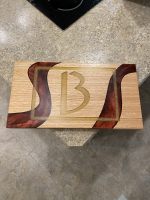Lets say I need to cut a specific path in a board. I make a template with my cnc and attach to the workpiece. The workpiece is 1-1/2 inches thick. What would be safer? Do I just take my 1/2 inch spiral flush trim bit and just do a full send on the piece or should I jigsaw close to the template path and cleanup with the flush bit? I tried the jigsaw method previously and my board was hard to control when I wanted to flush trim. I was getting unintended climb cuts which are scary. Thankfully no injuries. My theory on the full send was maybe since there is material on both sides of the bit the desire for the bit to climb cut on each side would cancel itself out. Thats just a theory. I could be very wrong in my thinking. I don't exactly need a bit that long every day and therefore I don't have much experience with longer bits apart from school when I had access to a shaper and pneumatic work holding sled.
I know a work holding sled would help but I didn't have one at the time and it would have to be custom because of the irregular shapes. I Know the template/workholding sled will need a way to swap out templates and have them secured plus have the ability to secure the workpiece to the sled. I was thinking the sled could have countersunk through holes for screws that would go into threaded inserts on the templates. on top of the sled would be a few pieces of t track to have some toggle clamps to hold the workpiece.
I know a work holding sled would help but I didn't have one at the time and it would have to be custom because of the irregular shapes. I Know the template/workholding sled will need a way to swap out templates and have them secured plus have the ability to secure the workpiece to the sled. I was thinking the sled could have countersunk through holes for screws that would go into threaded inserts on the templates. on top of the sled would be a few pieces of t track to have some toggle clamps to hold the workpiece.


